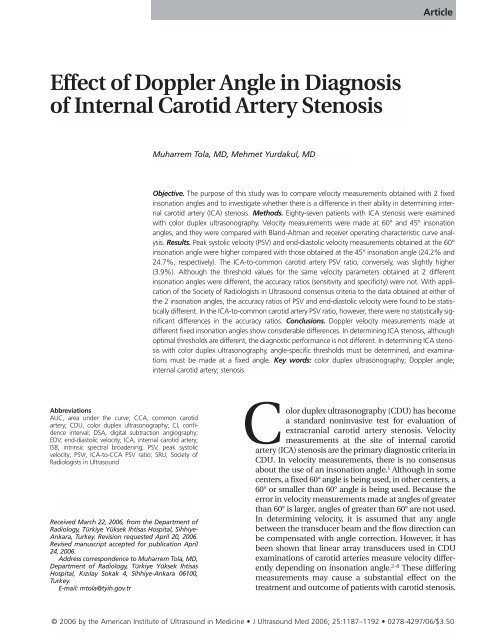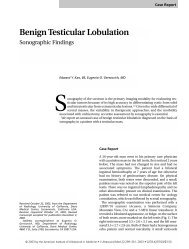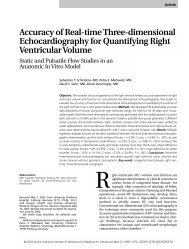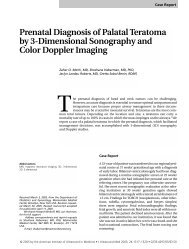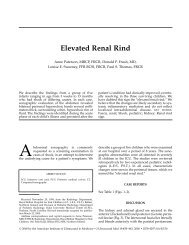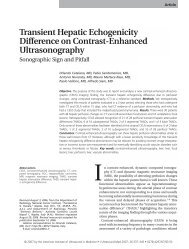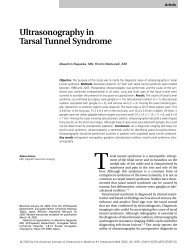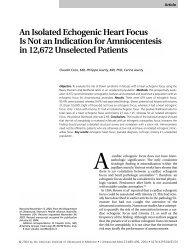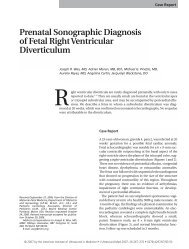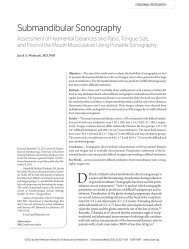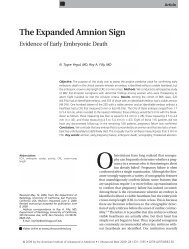Effect of Doppler Angle in Diagnosis of Internal Carotid Artery Stenosis
Effect of Doppler Angle in Diagnosis of Internal Carotid Artery Stenosis
Effect of Doppler Angle in Diagnosis of Internal Carotid Artery Stenosis
Create successful ePaper yourself
Turn your PDF publications into a flip-book with our unique Google optimized e-Paper software.
<strong>Effect</strong> <strong>of</strong> <strong>Doppler</strong> <strong>Angle</strong> <strong>in</strong> <strong>Diagnosis</strong><br />
<strong>of</strong> <strong>Internal</strong> <strong>Carotid</strong> <strong>Artery</strong> <strong>Stenosis</strong><br />
Abbreviations<br />
AUC, area under the curve; CCA, common carotid<br />
artery; CDU, color duplex ultrasonography; CI, confidence<br />
<strong>in</strong>terval; DSA, digital subtraction angiography;<br />
EDV, end-diastolic velocity; ICA, <strong>in</strong>ternal carotid artery;<br />
ISB, <strong>in</strong>tr<strong>in</strong>sic spectral broaden<strong>in</strong>g; PSV, peak systolic<br />
velocity; PSVr, ICA-to-CCA PSV ratio; SRU, Society <strong>of</strong><br />
Radiologists <strong>in</strong> Ultrasound<br />
Received March 22, 2006, from the Department <strong>of</strong><br />
Radiology, Türkiye Yüksek Ihtisas Hospital, Sihhiye-<br />
Ankara, Turkey. Revision requested April 20, 2006.<br />
Revised manuscript accepted for publication April<br />
24, 2006.<br />
Address correspondence to Muharrem Tola, MD,<br />
Department <strong>of</strong> Radiology, Türkiye Yüksek Ihtisas<br />
Hospital, Kızılay Sokak 4, Sihhiye-Ankara 06100,<br />
Turkey.<br />
E-mail: mtola@tyih.gov.tr<br />
Muharrem Tola, MD, Mehmet Yurdakul, MD<br />
Article<br />
Objective. The purpose <strong>of</strong> this study was to compare velocity measurements obta<strong>in</strong>ed with 2 fixed<br />
<strong>in</strong>sonation angles and to <strong>in</strong>vestigate whether there is a difference <strong>in</strong> their ability <strong>in</strong> determ<strong>in</strong><strong>in</strong>g <strong>in</strong>ternal<br />
carotid artery (ICA) stenosis. Methods. Eighty-seven patients with ICA stenosis were exam<strong>in</strong>ed<br />
with color duplex ultrasonography. Velocity measurements were made at 60° and 45° <strong>in</strong>sonation<br />
angles, and they were compared with Bland-Altman and receiver operat<strong>in</strong>g characteristic curve analysis.<br />
Results. Peak systolic velocity (PSV) and end-diastolic velocity measurements obta<strong>in</strong>ed at the 60°<br />
<strong>in</strong>sonation angle were higher compared with those obta<strong>in</strong>ed at the 45° <strong>in</strong>sonation angle (24.2% and<br />
24.7%, respectively). The ICA-to-common carotid artery PSV ratio, conversely, was slightly higher<br />
(3.9%). Although the threshold values for the same velocity parameters obta<strong>in</strong>ed at 2 different<br />
<strong>in</strong>sonation angles were different, the accuracy ratios (sensitivity and specificity) were not. With application<br />
<strong>of</strong> the Society <strong>of</strong> Radiologists <strong>in</strong> Ultrasound consensus criteria to the data obta<strong>in</strong>ed at either <strong>of</strong><br />
the 2 <strong>in</strong>sonation angles, the accuracy ratios <strong>of</strong> PSV and end-diastolic velocity were found to be statistically<br />
different. In the ICA-to-common carotid artery PSV ratio, however, there were no statistically significant<br />
differences <strong>in</strong> the accuracy ratios. Conclusions. <strong>Doppler</strong> velocity measurements made at<br />
different fixed <strong>in</strong>sonation angles show considerable differences. In determ<strong>in</strong><strong>in</strong>g ICA stenosis, although<br />
optimal thresholds are different, the diagnostic performance is not different. In determ<strong>in</strong><strong>in</strong>g ICA stenosis<br />
with color duplex ultrasonography, angle-specific thresholds must be determ<strong>in</strong>ed, and exam<strong>in</strong>ations<br />
must be made at a fixed angle. Key words: color duplex ultrasonography; <strong>Doppler</strong> angle;<br />
<strong>in</strong>ternal carotid artery; stenosis.<br />
olor duplex ultrasonography (CDU) has become<br />
a standard non<strong>in</strong>vasive test for evaluation <strong>of</strong><br />
extracranial carotid artery stenosis. Velocity<br />
measurements at the site <strong>of</strong> <strong>in</strong>ternal carotid<br />
artery (ICA) stenosis are the primary diagnostic criteria <strong>in</strong><br />
CDU. In velocity measurements, there is no consensus<br />
about the use <strong>of</strong> an <strong>in</strong>sonation angle. 1 Although <strong>in</strong> some<br />
centers, a fixed 60° angle is be<strong>in</strong>g used, <strong>in</strong> other centers, a<br />
60° or smaller than 60° angle is be<strong>in</strong>g used. Because the<br />
error <strong>in</strong> velocity measurements made at angles <strong>of</strong> greater<br />
than 60° is larger, angles <strong>of</strong> greater than 60° are not used.<br />
In determ<strong>in</strong><strong>in</strong>g velocity, it is assumed that any angle<br />
between the transducer beam and the flow direction can<br />
be compensated with angle correction. However, it has<br />
been shown that l<strong>in</strong>ear array transducers used <strong>in</strong> CDU<br />
exam<strong>in</strong>ations <strong>of</strong> carotid arteries measure velocity differently<br />
depend<strong>in</strong>g on <strong>in</strong>sonation angle. 2–8 C<br />
These differ<strong>in</strong>g<br />
measurements may cause a substantial effect on the<br />
treatment and outcome <strong>of</strong> patients with carotid stenosis.<br />
© 2006 by the American Institute <strong>of</strong> Ultrasound <strong>in</strong> Medic<strong>in</strong>e • J Ultrasound Med 2006; 25:1187–1192 • 0278-4297/06/$3.50
<strong>Doppler</strong> <strong>Angle</strong> <strong>in</strong> <strong>Internal</strong> <strong>Carotid</strong> <strong>Artery</strong> <strong>Stenosis</strong><br />
1188<br />
The purpose <strong>of</strong> this study was to compare<br />
velocity measurements obta<strong>in</strong>ed with 2 fixed<br />
<strong>in</strong>sonation angles and to <strong>in</strong>vestigate whether<br />
there is a difference <strong>in</strong> their ability <strong>in</strong> determ<strong>in</strong><strong>in</strong>g<br />
ICA stenosis.<br />
Materials and Methods<br />
Eighty-seven consecutive patients who were sent<br />
for digital subtraction angiography (DSA) were<br />
exam<strong>in</strong>ed with CDU before DSA. There were 60<br />
men and 27 women with a mean age <strong>of</strong> 65 years<br />
(range, 32–84 years). Patients were excluded from<br />
this study for the follow<strong>in</strong>g reasons: (1) if they<br />
had extensive calcification to obscure the ultrasonic<br />
signal <strong>in</strong> the stenotic area; and (2) if there<br />
was a situation for which duplex velocity measurement<br />
had no role (eg, occlusion and the<br />
str<strong>in</strong>g sign). The str<strong>in</strong>g sign is very high-grade<br />
carotid stenosis with long narrow<strong>in</strong>g <strong>of</strong> the poststenotic<br />
ICA. All patients gave their oral <strong>in</strong>formed<br />
consent, and the Institutional Review Board<br />
approved the study.<br />
Color duplex ultrasonography was performed<br />
with a LOGIQ 700 system (GE Healthcare,<br />
Milwaukee, WI) equipped with a 5- to 10-MHz l<strong>in</strong>ear<br />
array transducer. The common carotid artery<br />
(CCA) and ICA were scanned <strong>in</strong> transverse and<br />
longitud<strong>in</strong>al planes with the B-mode and color<br />
mode. Velocity waveforms were obta<strong>in</strong>ed rout<strong>in</strong>ely<br />
from the CCA <strong>in</strong> the center stream approximately<br />
2 cm below the bifurcation. The ICA was<br />
sampled proximally just beyond the bulb widen<strong>in</strong>g.<br />
When color flow imag<strong>in</strong>g showed areas <strong>of</strong><br />
abnormal flow, which appeared as heterogeneous<br />
color patterns, lum<strong>in</strong>al narrow<strong>in</strong>g, or both, the<br />
sample volume was moved slowly from proximal<br />
to distal <strong>in</strong> the ICA stenosis to obta<strong>in</strong> the highest<br />
flow velocity. To br<strong>in</strong>g out the change result<strong>in</strong>g<br />
from the <strong>in</strong>sonation angle more clearly, velocity<br />
measurements were made at 60°, which is the<br />
maximum angle suggested, and at 45°, which is<br />
the smallest angle found to be applicable <strong>in</strong> many<br />
carotid arteries (95%) <strong>in</strong> a prelim<strong>in</strong>ary study. The<br />
highest peak systolic velocity (PSV) and end-diastolic<br />
velocity (EDV) <strong>of</strong> blood flow <strong>in</strong> the CCA and<br />
ICA obta<strong>in</strong>ed at 45º and 60º were recorded. On the<br />
basis <strong>of</strong> these values, the ICA-to-CCA PSV ratio<br />
(PSVr) was calculated and recorded.<br />
Digital subtraction angiography was performed<br />
with a Polytron V 1000 angiographic unit (Siemens<br />
AG, Erlangen, Germany) by the Seld<strong>in</strong>ger technique.<br />
The degree <strong>of</strong> stenosis was assessed by<br />
compar<strong>in</strong>g the maximum stenotic area <strong>of</strong> the ICA<br />
with a more normal distal portion <strong>of</strong> the depicted<br />
ICA by North American Symptomatic <strong>Carotid</strong><br />
Endarterectomy Trial methods. 9 <strong>Stenosis</strong> was calculated<br />
as [1 – (s/n)] × 100, where s was the diameter<br />
<strong>of</strong> the maximum stenotic lumen, and n was<br />
the diameter <strong>of</strong> the normal vessel.<br />
The agreement between the measurements at<br />
45° and 60° <strong>in</strong>sonation angles was assessed by<br />
the Bland-Altman method. 10,11 The follow<strong>in</strong>g<br />
steps were made: (1) scatterplot <strong>of</strong> the measurement<br />
at a 45° <strong>in</strong>sonation angle aga<strong>in</strong>st the measurement<br />
at a 60° <strong>in</strong>sonation angle with the l<strong>in</strong>e<br />
<strong>of</strong> equality; (2) scatterplot <strong>of</strong> the percentage <strong>of</strong><br />
difference between 2 measurements aga<strong>in</strong>st<br />
their mean; and (3) calculation <strong>of</strong> the percentage<br />
<strong>of</strong> mean difference and 95% confidence <strong>in</strong>terval<br />
(CI) <strong>of</strong> the percentage <strong>of</strong> mean difference. The<br />
percentage difference between 2 measurements<br />
was calculated as (V 1 – V 2 )/(0.5 × [V 1 + V 2 ]), where<br />
V 1 and V 2 were the measurements at 60° and 45°<br />
<strong>in</strong>sonation angles, respectively. If the percentage<br />
<strong>of</strong> mean difference did not <strong>in</strong>clude 0 with<strong>in</strong> 95%<br />
CI limits, the difference between the 2 measurements<br />
was accepted to be statistically different.<br />
The PSV, EDV, and PSVr were evaluated by<br />
receiver operat<strong>in</strong>g characteristic curve analysis <strong>in</strong><br />
their ability to detect ICA stenosis <strong>of</strong> 50% or<br />
greater and 70% or greater. Receiver operat<strong>in</strong>g<br />
characteristic curves based on data obta<strong>in</strong>ed<br />
from CDU with 60° and 45° <strong>in</strong>sonation angles<br />
were compared by measur<strong>in</strong>g the areas under the<br />
curves (AUCs). For each <strong>Doppler</strong> parameter, the<br />
angle-specific threshold po<strong>in</strong>ts at which sensitivity<br />
and specificity are optimum were determ<strong>in</strong>ed.<br />
After the Society <strong>of</strong> Radiologists <strong>in</strong> Ultrasound<br />
(SRU) consensus criteria 1 (Table 1) were applied<br />
to the data obta<strong>in</strong>ed at either <strong>of</strong> the 2 <strong>in</strong>sonation<br />
angles and after the sensitivity, specificity, positive<br />
predictive value, and negative predictive<br />
value were calculated, they were compared. The<br />
McNemar test was used to determ<strong>in</strong>e any statistically<br />
significant differences between accuracy<br />
ratios (sensitivity and specificity).<br />
Table 1. Society <strong>of</strong> Radiologists <strong>in</strong> Ultrasound Consensus<br />
Velocity Criteria for <strong>Diagnosis</strong> <strong>of</strong> ICA <strong>Stenosis</strong><br />
Degree <strong>of</strong> Parameter<br />
<strong>Stenosis</strong>, % ICA PSV, cm/s ICA EDV, cm/s PSVr<br />
For statistical analysis, 2 s<strong>of</strong>tware products were<br />
used (MedCalc version 6.0 [MedCalc S<strong>of</strong>tware,<br />
Mariakerke, Belgium] and SPSS version 11.0.0<br />
[SPSS Inc, Chicago, IL]). P < .05 was considered to<br />
<strong>in</strong>dicate a statistically significant result.<br />
Results<br />
In our study, 19 carotid arteries were excluded<br />
(12 with occlusion, 5 with extensive calcifications,<br />
and 2 with the str<strong>in</strong>g sign). Velocity measurements<br />
could be made <strong>in</strong> all arteries with the<br />
60° <strong>in</strong>sonation angle. However, <strong>in</strong> 5 ICAs and <strong>in</strong><br />
A<br />
B C<br />
11 CCAs, the 45° <strong>in</strong>sonation angle could not be<br />
obta<strong>in</strong>ed for velocity measurements. As a result,<br />
for 155 arteries, 150 PSV and EDV values and 141<br />
PSVr values obta<strong>in</strong>ed at the 45° <strong>in</strong>sonation angle<br />
were <strong>in</strong>cluded for statistical evaluation. The reference<br />
standard DSA revealed that 90 (51.7%) <strong>of</strong> the<br />
carotid arteries had 0% to 49% stenosis; 36 (20.7%)<br />
had 50% to 69% stenosis; 36 (20.7%) had 70% to<br />
99% stenosis; and 12 (6.9%) were occluded.<br />
The relationship between the measurements<br />
obta<strong>in</strong>ed with both <strong>Doppler</strong> <strong>in</strong>sonation angles<br />
are shown graphically <strong>in</strong> Figure 1. Absolute<br />
velocity measurements (PSV and EDV) obta<strong>in</strong>ed<br />
with the 60° <strong>in</strong>sonation angle were higher than<br />
measurements obta<strong>in</strong>ed with the 45° <strong>in</strong>sonation<br />
angle. The PSVr, conversely, was slightly higher.<br />
However, <strong>in</strong> all 3 velocity parameters, the difference<br />
was found to be statistically significant<br />
(Table 2).<br />
Receiver operat<strong>in</strong>g characteristic curve analysis<br />
was performed for 50% to 99% and 70% to<br />
99% ICA stenosis on the basis <strong>of</strong> the data<br />
obta<strong>in</strong>ed with 45° and 60° <strong>in</strong>sonation angles on<br />
CDU. There was no difference between the<br />
AUCs <strong>of</strong> the same velocity parameters obta<strong>in</strong>ed<br />
at the 2 different <strong>in</strong>sonation angles (Tables 3<br />
Figure 1. Scatterplots show measurement <strong>of</strong> PSV (A), EDV (B),<br />
and PSVr (C) obta<strong>in</strong>ed at a 60° <strong>in</strong>sonation angle versus those<br />
obta<strong>in</strong>ed at a 45° <strong>in</strong>sonation angle by CDU. The dashed l<strong>in</strong>e<br />
<strong>in</strong>dicates the equality l<strong>in</strong>e.<br />
Tola and Yurdakul<br />
J Ultrasound Med 2006; 25:1187–1192 1189
<strong>Doppler</strong> <strong>Angle</strong> <strong>in</strong> <strong>Internal</strong> <strong>Carotid</strong> <strong>Artery</strong> <strong>Stenosis</strong><br />
1190<br />
Table 2. Comparison <strong>of</strong> Velocity Measurements<br />
Obta<strong>in</strong>ed at 60° and 45° Insonation <strong>Angle</strong>s by CDU<br />
Mean <strong>of</strong><br />
Measurement Difference, % 95% CI, %<br />
PSV 24.2 21.7–26.7<br />
EDV 24.7 20.2–29.3<br />
PSVr 3.9 0.5–7.4<br />
and 4). The optimal threshold values determ<strong>in</strong><strong>in</strong>g<br />
50% to 99% ICA stenosis with PSV, EDV, and<br />
PSVr measurements were 113 cm/s, 38 cm/s, and<br />
1.8, respectively, for the measurements obta<strong>in</strong>ed<br />
at the 45° <strong>in</strong>sonation angle and 137 cm/s, 42<br />
cm/s, and 2.1 for measurements obta<strong>in</strong>ed at the<br />
60° <strong>in</strong>sonation angle. The optimal threshold values<br />
determ<strong>in</strong><strong>in</strong>g 70% to 99% ICA stenosis with<br />
PSV, EDV, and PSVr measurements were 153<br />
cm/s, 51 cm/s, and 3.1 for the measurements<br />
obta<strong>in</strong>ed at the 45° <strong>in</strong>sonation angle and 231<br />
cm/s, 71 cm/s, and 3.6 for measurements<br />
obta<strong>in</strong>ed at the 60° <strong>in</strong>sonation angle. Although<br />
the threshold values for the same velocity<br />
parameters obta<strong>in</strong>ed at 2 different <strong>in</strong>sonation<br />
angles were different, the accuracy ratios (sensitivity<br />
and specificity) were not (Tables 3 and 4).<br />
With application <strong>of</strong> the SRU consensus criteria<br />
to the data obta<strong>in</strong>ed at either <strong>of</strong> the <strong>in</strong>sonation<br />
angles (Table 5), sensitivity and specificity <strong>of</strong><br />
PSVs and EDVs <strong>in</strong> determ<strong>in</strong><strong>in</strong>g 50% to 99% ICA<br />
stenosis were found to be statistically different<br />
(Table 6). In determ<strong>in</strong><strong>in</strong>g 70% to 99% ICA stenosis,<br />
however, whereas sensitivity and specificity <strong>of</strong><br />
PSVs and sensitivity <strong>of</strong> EDVs were statistically different,<br />
specificity <strong>of</strong> EDVs was not (Table 7). In<br />
general, whereas sensitivity was decreas<strong>in</strong>g <strong>in</strong> the<br />
45° data, specificity was <strong>in</strong>creas<strong>in</strong>g. In PSVr, however,<br />
there were no statistically significant differences<br />
<strong>in</strong> sensitivity and specificity.<br />
Table 3. Comparison <strong>of</strong> Diagnostic Performance <strong>of</strong> Velocity Measurements Obta<strong>in</strong>ed at 2 Fixed Insonation<br />
<strong>Angle</strong>s With CDU <strong>in</strong> Determ<strong>in</strong><strong>in</strong>g 50% to 99% ICA <strong>Stenosis</strong><br />
Optimum<br />
Insonation AUC Threshold<br />
Parameter <strong>Angle</strong>, ° (95% CI) Values Sensitivity, % Specificity, % PPV, % NPV, %<br />
PSV 60 0.946 (0.897–0.976) 137 cm/s 89 86 82 92<br />
45 0.951 (0.903–0.979) 113 cm/s 90 92 89 93<br />
P = .660 P > .9 P = .063<br />
EDV 60 0.916 (0.860–0.955) 42 cm/s 89 82 78 91<br />
45 0.882 (0.819–0.929) 38 cm/s 79 86 80 85<br />
P = .083 P = .07 P = .125<br />
PSVr 60 0.942 (0.889–0.974) 2.1 91 88 84 93<br />
45 0.955 (0.906–0.983) 1.8 93 85 82 95<br />
P = .285 P > .9 P > .9<br />
NPV <strong>in</strong>dicates negative predictive value; and PPV, positive predictive value.<br />
Table 4. Comparison <strong>of</strong> Diagnostic Performance <strong>of</strong> Velocity Measurements Obta<strong>in</strong>ed at 2 Fixed Insonation<br />
<strong>Angle</strong>s With CDU <strong>in</strong> Determ<strong>in</strong><strong>in</strong>g 70% to 99% ICA <strong>Stenosis</strong><br />
Optimum<br />
Insonation AUC Threshold<br />
Parameter <strong>Angle</strong>, ° (95% CI) Values Sensitivity, % Specificity, % PPV, % NPV, %<br />
PSV 60 0.92 (0.864–0.958) 231 cm/s 87 90 69 97<br />
45 0.92 (0.865–0.958) 153 cm/s 90 87 63 97<br />
P = .963 P > .9 P = .125<br />
EDV 60 0.917 (0.861–0.956) 71 cm/s 90 88 65 97<br />
45 0.88 (0.816–0.927) 51 cm/s 87 86 60 96<br />
P = .12 P > .9 P = .250<br />
PSVr 60 0.903 (0.843–0.946) 3.6 87 92 73 97<br />
45 0.927 (0.871–0.963) 3.1 89 88 66 97<br />
P = .233 P > .9 P = .375<br />
NPV <strong>in</strong>dicates negative predictive value; and PPV, positive predictive value.<br />
J Ultrasound Med 2006; 25:1187–1192
Discussion<br />
Our study shows that the velocity measurements<br />
made <strong>in</strong> carotid arteries at fixed angles <strong>of</strong> 45° and<br />
60° are different. The fact that the optimal threshold<br />
values created from the measurements<br />
obta<strong>in</strong>ed at these 2 fixed <strong>in</strong>sonation angles to<br />
determ<strong>in</strong>e ICA stenosis have similar accuracy<br />
ratios, despite their be<strong>in</strong>g different, reveals the<br />
necessity that <strong>Doppler</strong> exam<strong>in</strong>ation should also<br />
be standardized with respect to <strong>in</strong>sonation<br />
angle, and angle-specific stenosis criteria should<br />
be determ<strong>in</strong>ed. All the same, further studies <strong>in</strong><br />
larger patient populations are warranted.<br />
Conversion <strong>of</strong> frequency shift determ<strong>in</strong>ed by<br />
<strong>Doppler</strong> ultrasonography to velocity us<strong>in</strong>g a<br />
<strong>Doppler</strong> equation requires manual entry <strong>of</strong> the<br />
angle between the beam and the direction <strong>of</strong><br />
blood motion. Failure on the part <strong>of</strong> the operator<br />
<strong>in</strong> determ<strong>in</strong><strong>in</strong>g this angle with exact accuracy<br />
leads to faulty results. It is well known that us<strong>in</strong>g a<br />
<strong>Doppler</strong> angle <strong>of</strong> greater than 60° <strong>in</strong>creases the<br />
risk <strong>of</strong> error <strong>in</strong> determ<strong>in</strong><strong>in</strong>g the velocity because<br />
the error due to the cos<strong>in</strong>e term <strong>in</strong> the <strong>Doppler</strong><br />
equation <strong>in</strong>creases along with the <strong>in</strong>creas<strong>in</strong>g<br />
<strong>Doppler</strong> angle. Although an error <strong>of</strong> 5° made <strong>in</strong><br />
measur<strong>in</strong>g velocity measurement at a 45° <strong>Doppler</strong><br />
angle causes an error <strong>of</strong> only 9%, this error<br />
becomes 16% at 60° and 26% at 70°. The other<br />
source <strong>of</strong> error <strong>in</strong> connection with the <strong>Doppler</strong><br />
<strong>in</strong>sonation angle is the <strong>in</strong>tr<strong>in</strong>sic spectral broaden<strong>in</strong>g<br />
(ISB) effect <strong>of</strong> l<strong>in</strong>ear transducers. 2,4,5 This effect<br />
causes the actual maximal velocity to be overestimated.<br />
The overestimation is dependent on the<br />
<strong>in</strong>sonation angle, and it <strong>in</strong>creases with <strong>in</strong>creas<strong>in</strong>g<br />
<strong>in</strong>sonation angle. In vivo studies have also shown<br />
that there is overestimation <strong>in</strong> maximal velocity<br />
measurements at large angles. 3,7 Jogestrand et al 7<br />
Table 5. Comparison <strong>of</strong> Velocity Measurements Obta<strong>in</strong>ed at 60° and 45° Insonation <strong>Angle</strong>s With DSA Us<strong>in</strong>g<br />
SRU Consensus Criteria for ICA <strong>Stenosis</strong> <strong>Diagnosis</strong><br />
60° <strong>Angle</strong> <strong>of</strong> Insonation 45° <strong>Angle</strong> <strong>of</strong> Insonation<br />
Measurement DSA 0%–49% 50%–69% 70%–99% 0%–49% 50%–69% 70%–99%<br />
PSV 0%–49% 73 15 2 83 5 0<br />
50%–69% 1 23 10 12 17 3<br />
70%–99% 2 2 27 2 8 20<br />
EDV 0%–49% 69 21 0 79 9 0<br />
50%–69% 5 25 4 12 20 0<br />
70%–99% 2 6 23 4 13 13<br />
PSVr 0%–49% 76 14 0 71 10 0<br />
50%–69% 3 23 8 3 21 8<br />
70%–99% 2 3 26 2 5 21<br />
Table 6. Comparison <strong>of</strong> Accuracy Ratios With the Data Obta<strong>in</strong>ed at 45° and 60° Insonation <strong>Angle</strong>s Us<strong>in</strong>g<br />
the SRU Consensus Criteria <strong>in</strong> Determ<strong>in</strong><strong>in</strong>g 50% to 99% ICA <strong>Stenosis</strong><br />
Sensitivity, % Specificity, % PPV, % NPV, %<br />
Parameter Threshold 45° 60° P 45° 60° P 45° 60° 45° 60°<br />
PSV 125 cm/s 77 95 .001 94 81 .001 91 78 86 96<br />
EDV 40 cm/s 74 89 .004 90 77 .0001 84 73 83 91<br />
PSVr 2 92 92 >.9 88 84 .375 85 81 93 94<br />
NPV <strong>in</strong>dicates negative predictive value; and PPV, positive predictive value.<br />
Table 7. Comparison <strong>of</strong> Accuracy Ratios With the Data Obta<strong>in</strong>ed at 45° and 60° Insonation <strong>Angle</strong>s Us<strong>in</strong>g<br />
the SRU Consensus Criteria <strong>in</strong> Determ<strong>in</strong><strong>in</strong>g 70% to 99% ICA <strong>Stenosis</strong><br />
Sensitivity, % Specificity, % PPV, % NPV, %<br />
Parameter Threshold 45° 60° P 45° 60° P 45° 60° 45° 60°<br />
PSV 230 cm/s 67 87 .031 97 90 .008 83 69 92 97<br />
EDV 100 cm/s 43 74 .004 100 97 .125 100 85 88 94<br />
PSVr 4 75 84 .250 93 94 >.9 72 76 94 96<br />
NPV <strong>in</strong>dicates negative predictive value; and PPV, positive predictive value.<br />
Tola and Yurdakul<br />
J Ultrasound Med 2006; 25:1187–1192 1191
<strong>Doppler</strong> <strong>Angle</strong> <strong>in</strong> <strong>Internal</strong> <strong>Carotid</strong> <strong>Artery</strong> <strong>Stenosis</strong><br />
1192<br />
compared the measurements at 0° to 49° with those<br />
<strong>of</strong> 50° to 62°, whereas Logason et al 3 compared the<br />
measurements at a range <strong>of</strong> 25° to 57° with that <strong>of</strong><br />
fixed 60°.<br />
Jogestrand et al 7 obta<strong>in</strong>ed higher accuracy results<br />
at small <strong>Doppler</strong> <strong>in</strong>sonation angles. This result supports<br />
the fact that random operator errors made <strong>in</strong><br />
determ<strong>in</strong><strong>in</strong>g flow direction and the ISB effect are less<br />
at small angles. In our study, however, the accuracy<br />
ratios <strong>of</strong> the results obta<strong>in</strong>ed at 2 fixed <strong>in</strong>sonation<br />
angles were similar. When a fixed <strong>in</strong>sonation angle is<br />
used, the ISB effect has the same effect on all the<br />
exam<strong>in</strong>ations; consequently, the <strong>in</strong>consistencies<br />
result<strong>in</strong>g from the use <strong>of</strong> different <strong>in</strong>sonation angles<br />
disappear when fixed angles are used. Thomas et<br />
al 12 reported that PSVr was not affected by ISB error.<br />
Our study, <strong>in</strong> contrary to that, showed that there was<br />
a systematic (not random) difference, be<strong>in</strong>g a<br />
smaller proportion <strong>in</strong> comparison with the other 2<br />
absolute <strong>Doppler</strong> parameters, between the PSVr<br />
measurements obta<strong>in</strong>ed at 2 fixed <strong>Doppler</strong> angles.<br />
The answer to the question “In practice, what fixed<br />
<strong>in</strong>sonation angle should be used?” will clearly be<br />
“any <strong>in</strong>sonation angle at which the exam<strong>in</strong>ation can<br />
be done with ease, as long as it is less than 60°.” In<br />
vessels such as carotid arteries, which follow the sk<strong>in</strong><br />
surface relatively <strong>in</strong> parallel, measurements <strong>of</strong>ten<br />
cannot be made at small <strong>Doppler</strong> angles. In a vessel<br />
that lies completely parallel to the surface, exam<strong>in</strong>ation<br />
can be done with a 70° angle us<strong>in</strong>g ±20° steer<strong>in</strong>g.<br />
In our study, whereas all <strong>Doppler</strong> velocity<br />
measurements could be made at 60° with ±20° steer<strong>in</strong>g<br />
and transducer tilt<strong>in</strong>g when necessary, measurements<br />
<strong>of</strong> 5 (3%) ICAs and 11 (7%) CCAs could not be<br />
made at 45°. Because measurements can easily be<br />
made <strong>in</strong> the carotid artery at a 60° <strong>in</strong>sonation angle<br />
and also because a 60° fixed angle is widely used<br />
nowadays, the use <strong>of</strong> a 60° <strong>in</strong>sonation angle would<br />
be appropriate for the standardization <strong>of</strong> the carotid<br />
<strong>Doppler</strong> exam<strong>in</strong>ation technique.<br />
In those <strong>in</strong>stances when the vascular anatomy<br />
makes it impossible to perform an exam<strong>in</strong>ation at<br />
the determ<strong>in</strong>ed <strong>in</strong>sonation angle, <strong>in</strong>stead <strong>of</strong> absolute<br />
velocity measurements, it is appropriate to use<br />
the PSVr measurement, which is less affected by IBS<br />
error. In a case such as this, particular attention<br />
should also be paid to the correlation <strong>of</strong> the <strong>Doppler</strong><br />
spectrum with gray scale and color <strong>Doppler</strong> images.<br />
Additionally, if an exam<strong>in</strong>ation at the determ<strong>in</strong>ed<br />
<strong>in</strong>sonation angle is not possible, the <strong>in</strong>sonation<br />
angle at which the measurement is made should be<br />
noted for comparison dur<strong>in</strong>g the subsequent exam<strong>in</strong>ation.<br />
In conclusion, <strong>Doppler</strong> velocity measurements<br />
made at different fixed <strong>in</strong>sonation angles show considerable<br />
differences. In determ<strong>in</strong><strong>in</strong>g ICA stenosis,<br />
although optimal thresholds are different, diagnostic<br />
performance is not different. In determ<strong>in</strong><strong>in</strong>g ICA<br />
stenosis with CDU, angle-specific thresholds must<br />
be determ<strong>in</strong>ed, and exam<strong>in</strong>ations must be made at<br />
a fixed angle.<br />
References<br />
1. Grant EG, Benson CB, Moneta GL, et al. <strong>Carotid</strong> artery stenosis:<br />
gray-scale and <strong>Doppler</strong> US diagnosis—Society <strong>of</strong> Radiologists<br />
<strong>in</strong> Ultrasound Consensus Conference. Radiology 2003;<br />
229:340–346.<br />
2. Daigle RJ, Stavros AT, Lee RM. Overestimation <strong>of</strong> velocity and<br />
frequency values by multielement l<strong>in</strong>ear array <strong>Doppler</strong>. J Vasc<br />
Technol 1990; 14:206–213.<br />
3. Logason K, Barl<strong>in</strong> T, Jonsson ML, Bostrom A, Hardemark HG,<br />
Karacagil S. The importance <strong>of</strong> <strong>Doppler</strong> angle <strong>of</strong> <strong>in</strong>sonation on<br />
differentiation between 50–69% and 70–99% carotid artery<br />
stenosis. Eur J Vasc Endovasc Surg 2001; 21:311–313.<br />
4. Thrush AJ, Evans DH. Intr<strong>in</strong>sic spectral broaden<strong>in</strong>g: a potential<br />
cause <strong>of</strong> misdiagnosis <strong>of</strong> carotid artery disease. J Vasc Invest<br />
1995; 1:187–192.<br />
5. Hosk<strong>in</strong>s PR. Measurement <strong>of</strong> maximum velocity us<strong>in</strong>g duplex<br />
ultrasound systems. Br J Radiol 1996; 69:172–177.<br />
6. Ste<strong>in</strong>man AH, Tavakkoli J, Myers JG, Cobbold RSC, Johnston<br />
KW. Sources <strong>of</strong> error <strong>in</strong> maximum velocity estimation us<strong>in</strong>g l<strong>in</strong>ear<br />
phased-array <strong>Doppler</strong> systems with steady flow.<br />
Ultrasound Med Biol 2001; 27:655–664.<br />
7. Jogestrand T, L<strong>in</strong>dqvist M, Nowak J. Diagnostic performance<br />
<strong>of</strong> duplex ultrasonography <strong>in</strong> the detection <strong>of</strong> high grade <strong>in</strong>ternal<br />
carotid artery stenosis. Eur J Vasc Endovasc Surg 2002;<br />
23:510–518.<br />
8. Tahmasebpour H, Cooperberg P, Segan-H<strong>of</strong>fman J, Normand<br />
L, Fix C. Velocity quantifications <strong>in</strong> carotid ultrasound with<br />
<strong>Doppler</strong> angle set at 44 vs 60 degrees. Paper presented at:<br />
Annual Meet<strong>in</strong>g <strong>of</strong> the Radiological Society <strong>of</strong> North America;<br />
November 30, 2003; Chicago, IL.<br />
9. North American Symptomatic <strong>Carotid</strong> Endarterectomy Trial<br />
Collaborators. Beneficial effect <strong>of</strong> carotid endarterectomy <strong>in</strong><br />
symptomatic patients with high-grade carotid stenosis. N Engl<br />
J Med 1991; 325:445–453.<br />
10. Bland JM, Altman DG. Statistical methods for assess<strong>in</strong>g agreement<br />
between two methods <strong>of</strong> cl<strong>in</strong>ical measurement. Lancet<br />
1986; 8:307–310.<br />
11. Bland JM, Altman DG. Measur<strong>in</strong>g agreement <strong>in</strong> method comparison<br />
studies. Stat Methods Med Res 1999; 8:135–160.<br />
12. Thomas N, Taylor P, Padayachee S. The impact <strong>of</strong> theoretical<br />
errors on velocity estimation and accuracy <strong>of</strong> duplex grad<strong>in</strong>g<br />
<strong>of</strong> carotid stenosis. Ultrasound Med Biol 2002; 28:<br />
191–196.<br />
J Ultrasound Med 2006; 25:1187–1192


